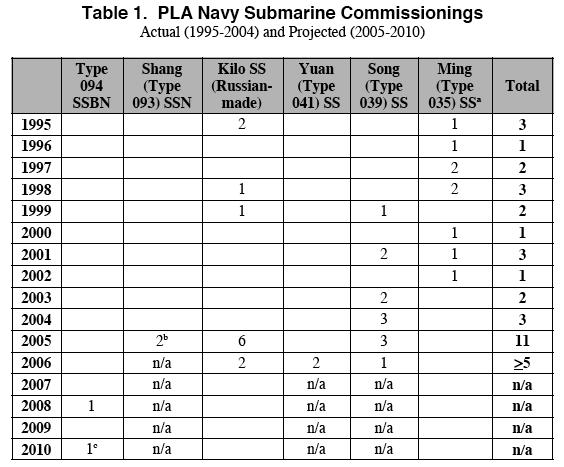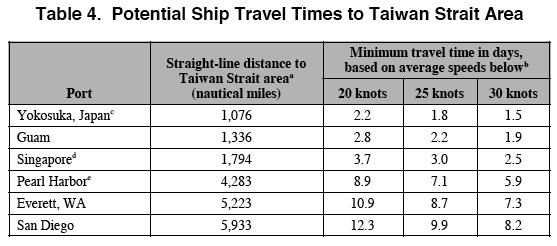
As we watch the SECNAV try to tie together a broken shipbuilding program - there is an article in The International Tribune that should grab your attention - though nothing new to regular readers here - The rise and fall of navies. It pulls together some bits from the Congressional Research Service's, China Naval Modernization: Implications for U.S. Navy Capabilities.
By 2010, China's submarine force will be nearly double the size of the U.S. submarine feet The entire Chinese naval fleet is projected to surpass the size of the U.S. fleet by 2015.After discussing the wilting European navies - and I would add our own shrinking one; this jewel,
This leads to an obvious, final question: What do naval strategic planners in the one continent assume about the future of the world that the planners in the second continent do not? Why is Chinese public television showing programs about the rise of Elizabeth I's navy at the same time that the British Ministry of Defense is mothballing or scrapping warships with names that go back over 400 years?I'm not going to talk a lot about the details of the attached grids from the CRS document (read it all, please) because they speak for themselves. The rate the Chinese fleet is building, - don't discount them, remember our "OK" Sherman "Ronsons" defeated the "Perfect" German tanks by numbers in WWII) - and the tyranny of distance we have to show up for the game as the facts change on the ground are serious considerations you have to think about.
Armchair strategists will rush in with many answers to that question: For example, that Asia is more likely to see interstate conflicts in the future than Western Europe, China is determined to curb U.S. hegemony in the Pacific and everyone else is scared of China's military build-up, and, in any case, these faster-growing economies can afford both guns and butter. All of that may be true. But the plain fact remains that, in an age of great geopolitical uncertainties, the leading European nations are ignoring the ancient Elizabethan caution: "Look to thy Moat." Can that really be wise?
Remember, that does not include the time it would take for East Coast ships to get to the area. And for the building program, it isn't the navy that they will have in 2010 we need to think about - it is 2020.
As the Chinese are working their Navy around something proved for, well, 2,500 years, know as "ships at sea" - we are trusting everything on "Bullsh1t Bingo" buzzword programs that have not been built, tested, or validated. Oh, and as I have said over and over again - if you rely on the electromagnetic spectrum, communications, and satellites to win - I will defeat you. The Chinese know this. Here is our substitute for the hard work that is ASW,
Jason Ma, “ASW Concept Of Operations Sees ‘Sensor Rich Way Of Fighting Subs,” Inside the Navy, February 7, 2005. A January 2005 article stated: The Navy cannot fight diesel subs with “force on force,” such as sending one sub to defeat another sub, because that is not cost effective, [Rear Admiral John Waickwicz, chief of Fleet Anti-Submarine Warfare Command] told Inside the Navy. For example, the new Virginia-class subs cost about $2 billion each, while advanced diesel subs cost hundreds of millions of dollars each.This is all built on Clark's folly.
Instead of force on force, ASW tactics will emphasize using networked sensors and communications to allow one platform — like a sub, Littoral Combat Ship, or aircraft — to defeat multiple diesel subs, he said. “You have to be able to destroy them at a very large rate, because potential enemies may have a large number” of subs, he explained.
“We don’t have that luxury to go one against one anymore,” he added, noting that individual ASW platforms will rely on their greater capability to take on multiple subs. (Jason Ma, “Admiral: Navy’s ASW Tactics To Be Aggressive And Offense-Minded,” Inside the Navy, January 17, 2005.)
In December 2004, the Navy approved a new concept of operations (CONOPS) a new general approach — to ASW. As described in one article,The CONOPS, BTW, is fantasy and full of FOD. Here is how the now-Beltway Bandit brushed aside reality for his PowerPoint,The Navy’s new concept of operations for anti-submarine warfare calls for the use of standoff weapons, networked sensor fields and unmanned vehicles to detect and attack diesel submarines in littoral waters, rather than a reliance on “force on force” engagements.
Chief of Naval Operations Adm. Vern Clark approved the CONOPS Dec. 20, according to a Navy spokesman. The five-page document will guide the development of a comprehensive ASW master plan that is expected to be classified, though it might have an unclassified version.
The CONOPS envisions hundreds or thousands of small sensors that would “permeate the operating environment, yielding unprecedented situational awareness and highly detailed pictures of the battlespace.” Attack submarines that today carry sensors and weapons could in the future provide logistical support to and serve as command and control bases for off-board sensors and “kill vehicles,” the CONOPS states. The networking of autonomous sensor fields with manned and unmanned vehicles will change ASW from a “platform-intensive” to a “sensor-rich” operation, it adds.
At a June 20, 2005, conference on the future of the Navy organized by the American Enterprise Institute (AEI), Admiral Vernon Clark, who was the Chief of Naval Operations until July 22, 2005, stated:Just because you sign something does not mean it is going to happen or can be operationalized. Just because you "believe" something does not mean the the Belief Fairy is going to wave its wand and make it happen.[The Chinese are] building submarines at a rapid rate. They’re buying them from other countries. They’re building their own capabilities. And let me just to make a long story short, I published a new ASW concept [of operations] a couple of months ago. I fundamentally don’t believe that the old attrition warfare[,] force on force anti-submarine warfare[,] construct is the right way to go in the 21st century. [The questioner] mentioned that I had spent part of my past life in the submarine warfare business. I have. I trailed the Soviets around. I know what that’s about. And what I really believe is going to happen in the future is that when we apply the netted force construct in anti-submarine warfare, it will change the calculus in that area of warfighting forever. And it will be a courageous commander who decides that he’s going to come waltzing into our network.
This pie in the sky just does not exist in reality. When you start believing your own BS, you are in trouble.
Further on, I like this commentary,
As discussed earlier, the Navy plans to shift to a new, less platform-intensive ASW concept of operations. The Navy also plans to introduce new ASW-capable platforms in coming years, including a substantial number of Littoral Combat Ships (LCSs). Fully realizing the new ASW concept of operations, however, may take some time, particularly in light of the technical challenges involved, and LCSs will not be available in large numbers until after 2010. This raises a potential question of whether the Navy will have enough ASW-capable ships and aircraft between now and 2010, and whether the Navy should reactivate recently retired ASW-capable platforms and keep them in service until the new ASW concept is substantially implemented and larger numbers of LCSs and other new ASW-capable platforms join the fleet.The new ASW CONOPS is FOD and unrealistic; check. The LCS are in trouble - and they have not even built the ASW module, tested, trained or validated it; check. Can't reactivate the Spruance Class, they have mostly been sunk and the OHPs given away or sunk; check. Many of us have been warning about the Chinese build-up since the 90s - but were dismissed; check. ASW training on the type of submarines the Chinese have is so substandard that we had to hire a Swedish submarine and pay for them to vacation, errrr, operate out of SoCal; check. The few P-3s we have left are used a lot for overland ISR and are about out of fatigue life - and the boneyard birds are only worth taking apart - there is no bringing back ASW capable S-3s.
Advocates of this option could argue that the recent retirements of ASW capable platforms occurred before the dimensions of the PLA Navy submarine modernization effort were fully understood. Opponents could argue that even with these recent retirements, the Navy retains a substantial number of such platforms, including SSNs, Aegis cruisers and destroyers, remaining Oliver Hazard Perry (FFG- 7) class frigates, carrier- and surface combatant-based SH-60 helicopters, and remaining P-3s. They could also argue that there are more cost-effective ways to improve the Navy’s ASW capabilities between now and 2010, such as increased ASW training and exercises (see discussion below).
More truth here,
The possibility that the LCS’s AAW system might be overwhelmed or exhausted by attacks from multiple ASCMs raises the question of whether the AAW capability planned for the LCS should be increased. Options for increasing the LCS’s planned AAW capability include, among other things, adding another 21- round RAM launcher or supplementing the currently planned RAM launcher with a battery of Evolved Sea Sparrow (ESSM) missiles. In assessing such options, one factor to consider would be whether installing additional RAMs or ESSMs would require an increase in the planned size and cost of the LCS.SECNAV Winter, faster please.
Hat tip Bill Ashton.

No comments:
Post a Comment